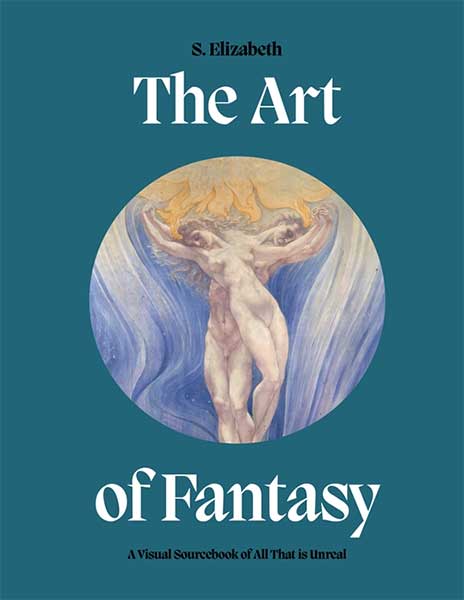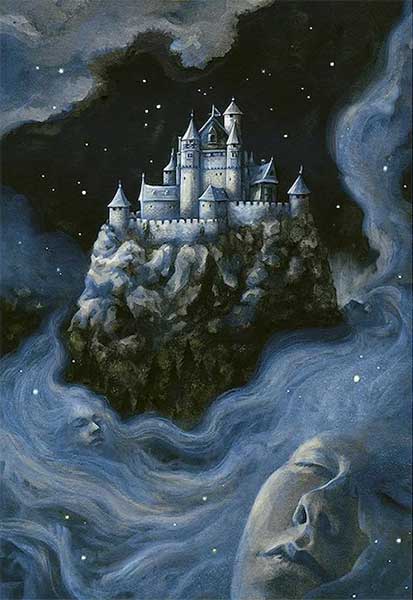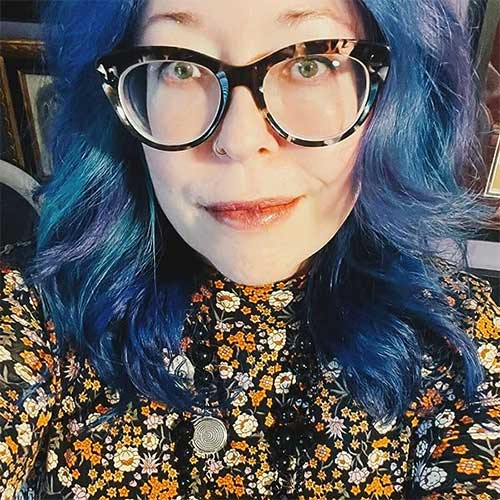
The Art of Fantasy, S. Elizabeth (240pp, Frances Lincoln)
Framed as ‘A Visual Sourcebook of All That is Unreal’, S. Elizabeth has compiled a beautiful compendium of art that evidences what she calls ‘The Irresistible Allure of the Unreal.’ Despite acknowledging that fantasy is ‘A sweeping though loosely defined art genre’, Elizabeth’s excitement about ‘the uncharted and the unknown, worlds full of magic and mythical creatures’ is contagious, generating an enthusiam for what follows, namely three sections of loosely grouped images – Beasts & Beings, Quest for Knowledge and Worlds Apart – each subdivided into a trio of thematic subjects.
There is a wonderful mix and juxtaposition of works here: Pre-Raphaelite paintings, modern airbrushed art, illustrations for children’s books, surrealist images, historical printy and medieval illuminations and marginalia rub shoulders with William Blake and outsider and naive art. We start with ‘Creatures Great and Small’, and are introduced to Aslan the Lion, unicorns, horses, bats, cats, sphinxes, dragons and a lone faun dancing in the twilight. ‘Almost Human’ is an even more engaging compilation of mermaids, dryads, nymphs, manticores, vampires and priestesses, not to mention Medusa, Giger’s Alien and a personification of Winter.

As if these weren’t impossible enough, Elizabeth’s next gallery gathers up ‘Impossible Monsters’, including Godzilla, several dragons, Grendel and a rather awful sculpture of ‘The Beautiful Crustacean’, which is neither beautiful nor very obviously a relative of a lobster or crab… In fact it’s an image which raises the main problem I have with this book, which is that the most recent and contemporary images here are not a patch on the more historical (and presumably copyright free) ones.
Carl Grauer’s The Oz Altarpiece, featured among the ‘In Our Dreams’ selection, seems to me to be doing something very different from the work which keeps it company. The perhaps ironic or comedic elevation of Dorothy to a deity, complete with Shiva’s four arms and a straw hat halo, seems to be a product of Pop Art and appropriation, recontextualisation and a discussion of religiosity, popular culture and fame. Very different to the coy, awkward watercolour from Alice’s Adventures in Wonderland on the facing page. Elsewhere, dreamers and dreams are mostly depicted in terms of languorous, sleeping females, sometimes with the products of their dreams – be they angelic or demonic – shown alongside them, or moody characters swept up in daydreams, gazing into the distance…
There’s then a strange jump in this Quest for Knowledge between the consideration of dreams to the persuasive ‘Magic Is Real’. Elizabeth’s brief introduction here is a little confused, slipping away from magic towards ‘magic-wielders’ and the magical. It is the characters from magic tales that are mostly evidenced here: a wonderful Fairy Godmother for Cinderella, Burne-Jones’ hermetic Wizard, Fludd’s engraving of an astrologer, and more fairies, seers, witches, sorceresses and prophetesses. Again, it’s let down by some embarrassingly slick and hyperreal contemporary work, particularly a 1997 witch floating in front of her computer, both her and her rather wooden black cat familiar within a circle of chalked symbols. Fortunately, a rather beautiful, if art-deco-esque comic cover for a 2019 Neil Gaiman text reminds us there is good stuff out there.
‘Faith & Philosophy’ follows and is a rather awkward title which is allowed to encompass the likes of Saints, alchemy, a hare-brained archbishop, the stories of King Arthur and of Icarus, Klimt’s The Kiss and some mystical roses. Nice work but not sure about the title. Sorry! Better are the groupings of ‘Forgotten Realms & Wonderlands’, ‘Time Travel, Alternate Histories & Parallel Universes’ and ‘How to Save the World’ which constitue the final third of the book.
Here are Salvador Dali, Hieronymus Bosch and Richard Dadd, warring fishes, The Rainbow Factory, The Land of Dreams and more images from Fairy Land. To get around there are flying buses, flying ships, flying trains and The Stairway to Heaven. (Not the Led Zeppelin one.) Saving the world is, apparently, in the hands of heroes and superheroes such as Robin Hood, Rustham, Brunwhilde, packs of gnomes, Conan and The Wounded Healer’s Blood [which] Nourishes the Earth That Gives Birth to Radiant Flowers.
Although I would wish for a little more drift towards science fiction and some better contemporary art here, in the main this book contains an original and quirky selection, selected and arranged to help convince us that ‘Fantasy is not simply an escape from the dreariness of daily life; it is the irresistible impulse that reveals hope and wonder in us all.’ You can’t say fairer than that, can you?

.
Rupert Loydell
.
